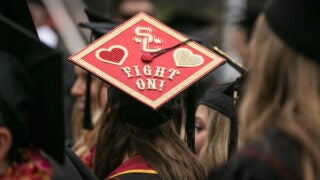USC announces fall admissions statistics
Nearly 46,000 accomplished high school seniors from every U.S. state and 123 other countries applied for an estimated 2,650 places in this fall’s entering class of USC, reflecting growing interest from international students and U.S. applicants.
The admitted group was selected from a highly competitive and diverse pool of 45,917 applicants with broad geographic, ethnic and socioeconomic representation. This represents an 18 percent admission rate, the lowest in USC’s history.
“USC continues to be a very popular choice among students throughout the United States and around the world,” said Timothy Brunold, USC dean of admission. “The academic quality, diversity and character of this year’s group of admitted students is fantastic. I am confident that we have selected a group of students whom our faculty will enjoy teaching and who will gain great benefit from USC’s academic opportunities and location in Los Angeles.”
The strong academic records of this year’s applicants tell a large part of the story, said Kirk Brennan, USC director of admission. The average admitted freshman completed six Advanced Placement and International Baccalaureate courses in high school. Ninety percent of admitted freshmen rank in the top 10 percent of their high school’s graduating class and 75 precent of admits have standardized test scores above the 95th percentile. The average un-weighted high school grade point average is 3.82 on a 4-point scale.
But with so many applicants with impeccable academic records, Brennan said the distinctions in choosing a freshman class became much more nuanced. Through personal essays and recommendations, USC’s admission staff learned about a student conversant in four languages (even creating his own) hoping to major in linguistics; a New Orleans student who thrived in high school despite being displaced by Hurricane Katrina; and a student planning to major in international relations who founded an organization that focuses on global issues.
“It would be pretty easy to simply calculate a GPA and sort it all out using formulas, but I think our faculty want us to be focused on students who will be engaged, who will make a difference in the classroom, in discussions, in the laboratory, the library or the community,” Brennan said. “We want students with different points of view so that all will be challenged to think more broadly.”
Some other facts about the group of admitted students for fall 2012:
• Forty-seven percent of admitted students are from California, with 13 percent representing 70 foreign countries. The remaining 40 percent come from the other 49 states and U.S. territories.
• Thirty percent of admitted students are Asian, 12 percent Latino, 6 percent black and 2 percent Native American/Pacific Islander. Overall, 20 percent are from underrepresented minority populations (black, Latino or Native American). In addition, 12 percent of admitted students would be the first in their families to attend college. USC enrolls more underrepresented minority undergraduates than most private research universities in the country: 3,272 as of fall 2011 or 19 percent of all undergraduates.
• Outside California, the leading U.S. metropolitan areas for students admitted to USC are, in order: New York City, Chicago, Seattle, Washington, D.C., Dallas and Boston. The most-represented foreign countries are China, South Korea, India, Canada and Taiwan.
In a Princeton Review ranking, USC was named a top 10 dream school among both college applicants and their parents in a nationwide survey, along with Harvard, Stanford, Princeton and Yale universities and the Massachusetts Institute of Technology.
And for the third time in four years, USC will increase its undergraduate financial aid budget this fall. The university believes its pool of university-funded aid to be the largest of any private university in the country.
More than 65 percent of USC undergraduates receive some form of financial aid. USC admits students without regard to ability to pay and meets the full need of admitted students. USC enrolled 23 percent low-income undergraduate students in fall 2011, as defined by Pell Grant eligibility. Students’ socioeconomic status has no impact on their graduation rate.
Accepted freshmen have until May 1 to decide if they will enroll.



